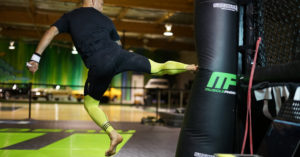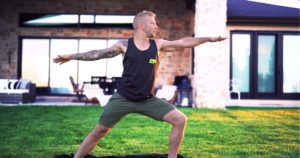Weak kicks can be dangerous.
Combine the instability of being on one foot with a not-so-strong core and a lack of speed, and you’ll be setting yourself up for a KO.
Of course, you may not even be considering being in the octagon with your training, but the fact remains that training to throw kicks properly can actually benefit your entire regime and body. By training for explosive movements (which kicks are) you improve your endurance and speed, which are useful for any scenario, while also improving balance and body awareness.
Improving Kicks: The Tips
These kick tips have been developed over years of trial, error, and study, and you’ll notice that most are actually extremely simple to implement into your daily routine and training.
Keep in mind that for a full-blown, in-depth training on all the insider ways to improve kicks not included here, you’ll also want to check out the Fit to Fight Course, which you can read more about below.
1. Don’t Square Off
One of the early mistakes I see with kicks (especially low kicks) is the tendency to square off with your opponent before throwing a kick. By squaring off, I mean aligning yourself directly in front of your opponent, which is a dangerous spot to be since you’ll be on one leg and in the line of fire of a jab or hook. Instead, try to position yourself slightly to their right or left before throwing your kick so you can maneuver outside of a jab or hook.
2. Add in Jumps

Since all kicks are explosive moments, it’s so important to add in jumps and plyometric moves to improve the speed and strength of your kicks. These help train your fast-twitch muscle fibers responsible for firing quickly when you need a powerful kick to launch quickly and powerfully.
As a bonus, jump and plyo training is a serious workout for your entire body. It often falls into the category of HIIT training, which has been shown to increase stamina and boost your endurance capacity like nothing else, while also improving learning and memory. [*]
Try adding in moves like jump squats, box jumps, alternative jump lunges, and burpees with jump-knee tucks.
3. Careful with Arm Swings
*Skip to 00:45 second mark
Another thing to pay attention to with kicks is arm swinging. As I explain in the video, most people want to swing their arms dramatically to gain momentum and power in their kicks; however, this can alert your opponent to your kick. It can also cause you to rely less on your core to propel your kicks (more on that below).
Try instead to focus on keeping your arms up during your kicks, which will also encourage less reliance on momentum and more on actual leg and core power when you deliver a blow.
4. Core Training

All kicks require core strength. Even the simple act of lifting your leg at any angle activates the entire trunk of your body.
You’ll notice that when you throw most kicks, you’re also rotating your body for power and momentum, which especially stems from your obliques. Training your core with leg lifts, rotation exercises that work your obliques (like the weighted lunge with rotation image above), and planks improves your power output, balance, and stability so that you can throw extremely powerful kicks without swinging your arms to alert your opponent to a kick.
Also be sure to incorporate exercises like hanging leg lifts to train your lower abs to easily lift the weight of your legs so you can explode into your kicks.
5. Improve Balance

We touched on balance when we discussed focusing on core training, but I want to underline the importance of balance training in order to land kicks. When you throw a kick, you’re putting a lot of momentum into the movement, on one leg none-the-less. Whether that kick lands or not, you need to be able to control the momentum when it comes to a stop, and also avoid stumbling or losing stable footing during the kick. This leaves you open and vulnerable to your opponent, who will strike the second they see you off balance.
Add in asymmetrical training movements that challenge your balance and strengthen your stability muscles, like single-legged deadlifts, and even yoga poses.
Follow-Along Drills and Techniques: Fit to Fight Course
I know it’s priceless to see these techniques and tips in action, which is why I’ve included the lowdown on effective kicking techniques in video format in my Fit to Fight Course. You’ll see the tips here demonstrated in action (plus many other important ones not included here that are reserved for course members only!) so you can follow along and improve quickly, while also shredding fat, improving functional strength and stamina for on and off the mat, and finally getting the gains you’ve always wanted.
Check it out here and share if you’ve discovered any effective kicking techniques below!
I’ve seen TJ Dillashaw get knockouts with his high kicks. Which is more important high kicks or leg kicks?
Kaz, leg kicks will wear an opponent down and high kicks are more likely to get blocked or cause a knock out. Both are effective and should be used. But depending on the plan for the fight, one could be more important than the other.